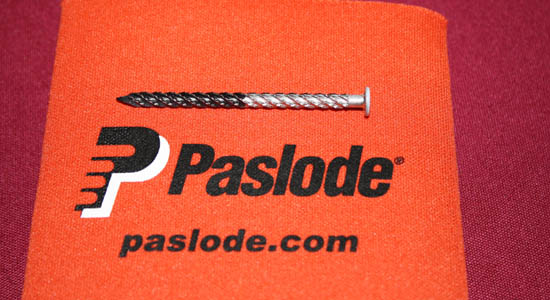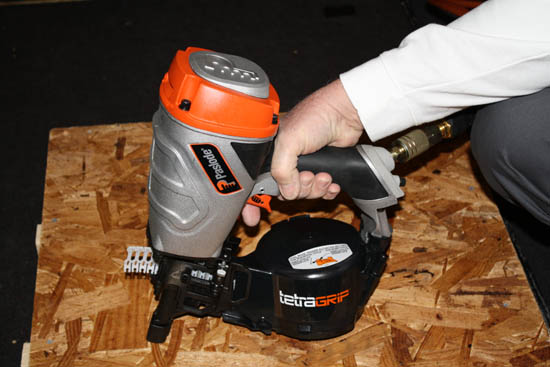The Paslode® TetraGrip™ Fastening System A Revolution In Subfloor Fastening
Drives Like A Nail. Holds Like A Screw.™
(Vernon Hills, IL) – The Paslode® TetraGrip™ Subfloor Fastening System is a technological breakthrough in subfloor fastening for the residential builder. With its dedicated pneumatic coil nailer, the TetraGrip™ fastener drives like a nail and holds like a screw. But its revolutionary barb-threaded design eliminates subfloor nail squeaks* while delivering the holding power of a floor screw.** This translates into increased jobsite productivity, fewer call backs for repairs and greater homeowner satisfaction.

“Paslode’s goal has always been to create fastening systems that solve construction problems while increasing efficiencies and productivity for the home builder and the trades,” said Christelle Imhof, Market Manager for Paslode. “Builders who have field tested the TetraGrip™ Subfloor Fastening System are convinced of its effectiveness and superior performance. We believe it will change forever the way builders fasten floor sheathing in residential construction.”
The key to TetraGrip™ technology is the proprietary nail shank design. It drives as fast as a nail, but rotates as it drives to bond with the wood fibers. The features that make TetraGrip™ a revolutionary squeak-eliminating fastener include:
- Rotation without destruction – the optimized barbed helix creates high rotational forces and minimal friction.
- Strong non-destructive wood interaction – efficient rotation eliminates wood destruction when driven.
- Superior withdrawal resistance – the barbed helix-to-wood engagement creates a high load capacity. In fact, the TetraGrip™ fastener is 2-3/8” x .113 or equivalent to a 6d nail, which typically requires 54 nails per panel, according to code. The ESR for the TetraGrip™ Subfloor Fastener recognizes superior withdrawal values, equivalent to a floor screw, which reduces the number of fasteners needed per panel to 38.
- Unique barbed thread – the fastener shank was specifically designed so that there is no smooth surface to rub on the subfloor panel, thus no squeaks.
Today, to alleviate floor squeaks, many subfloor installers use glue before they nail the subfloor down. Some builders require the use of screws in addition to or partially in place of nails. Some builders even have a separate contractor come back after the subfloor is initially installed to fully screw down the floor panels. This adds tremendous costs in terms of time, labor and material as well as complexity to coordinate the work, making for an inefficient three-step process – gluing, nailing, screwing. Plus, by still using nails in the initial installation step, the potential for the subfloor to squeak remains.
By using the TetraGrip™ Subfloor Fastening System, builders reduce the steps it takes to secure the subfloor and dramatically reduce the potential for squeaks. “Many builders who have field-tested or adopted the TetraGrip™ System have been able to eliminate using glue in the initial installation,” explained Imhof, “and they find no need to come back and add screws after the floor is fastened.”
In essence, the TetraGrip™ Subfloor Fastening System offers the best of both worlds: the holding power of a 2” floor screw combined with the installation speed of a nail. Subfloor installation suddenly becomes a one-step fastening process. No more gluing or switching between nails and screws, or coming back later to finish the job. You put down the panels, you fasten them immediately and you’re done. Builders have the peace of mind of knowing that this fastener will hold in place and will not induce squeaks, meaning greater homeowner satisfaction and fewer call backs.
The TetraGrip™ Subfloor Fastening System is designed for production work with a dedicated pneumatic coil framing nailer, Model PF237C, engineered to drive the TetraGrip™ fastener. Each coil holds 120 TetraGrip™ fasteners. The TetraGrip™ subfloor fastener is made in the USA and is recognized by ICC-ES under ESR-3071.
The TetraGrip™ Subfloor Fastening System is available selectively during the initial roll out by calling Paslode at 1-800-468-7403.
*Subfloor nails have continued to be the primary culprit in subfloor squeaks. Although quaint in an old home, floor squeaks are an annoyance in a brand new home, often resulting in a call back repair for the builder. A nail can become loose in the subfloor for many reasons; the primary reason being a drop in moisture when the house is buttoned up. This causes the lumber to dry, retract around the nails and cause some nails to “pop.” The shank of the nail then rubs against the floor sheathing causing a squeak.
**As compared to a 2” #8 wood screw.
About the author
2 Comments
Leave a comment
Disclosure
Product reviews on this site contain our opinion of a product or service. We will always strive for objectivity and transparency in our reviews. Our goal is to provide readers with honest, objective information based on our own experiences. We never have and never will accept payment in exchange for a positive review. Many of the products that we review are provided to us for free by a manufacturer or retailer. In some cases, we also have advertising or affiliate relationships with manufacturers and retailers of products and services we review. For additional information please visit our additional disclosure policies.
























This really is a cool system. During this economy, anything that minimizes the number of call-backs is going to be big news for larger volume builders. The money they lose going back out to deal with squeaky floors alone is staggering.
Bryan – I know for me as a builder a floor squeak can cost thousands of dollars and be a huge disruption for a home owner. This is a really big deal in the framing world.